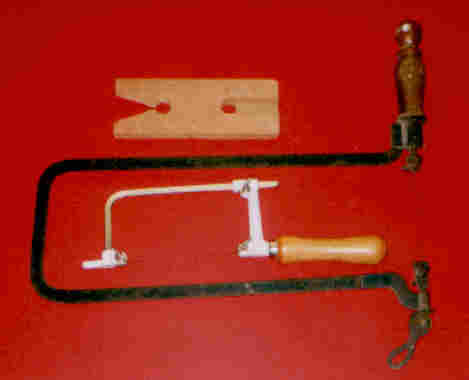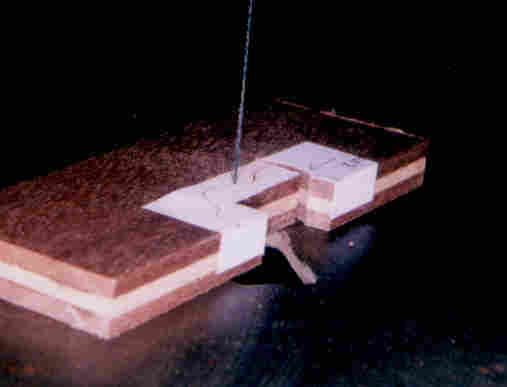



Updated January 2007
Fretsaws and Fretsawing
Go to Main Menu
Return to Techniques Index
Return to Tools Index

| Cutting table |  |
| Traditional fretsaw frame |  |
| Piercing saw |  |
Cutting table
The cutting table is fixed to the work top with a clamp, this being supplied with the table.
Traditional fretsaw frame
The long length of the throat, the distance between the blade and the rear of the frame, is required when fretworking full size work. As a saw, it is bulky to handle and requires practice to master.
Piercing saw
This, or the similar sized coping saw, is a much more easily handled tool.
Applying blade tension
The blade tension is the same for all saws.
First fit one end of the blade to one of the clamps.
If tension
can be applied by twisting the handle, fit the second end to it's clamp and then
twist the handle until a relatively high pitch sound is obtained when the blade
is "plucked".
If tension can be applied by an eccentric cam at
one end of the frame, fit the second end while squeezing the frame slightly.
Turn the eccentric cam to tighten the blade. "Pluck" the blade when a relatively high
pitch sound should be obtained.
The pattern
The pattern to be cut can be drawn directly
onto the timber but it is better to use a
pattern photocopied from a design or drawn
on paper. This is then fitted to the timber with a photomount adhesive. Although
this is not a permanent adhesive, it quickly adheres to the timber and patterns
should therefore be attached immediately before sawing and removed immediately
afterwards.
Using the fretsaw
The timber is placed with the position to be cut over the "V" throat of the table. Keeping the blade vertical, saw with a steady up-down movement applying sufficient pressure to enable the blade to cut through the wood without "bending" the blade more than a few millimetres. The rate of progress will depend on both the species and thickness of the timber.
Practice!
As with most skills, practice improves the ability but using the correct timber also helps. Jelutong (see the miscellaneous pages for details) is ideal fo making dolls house furniture and its use is recommended from the start. Obechi is available from many sources but this is NOT recommended as it is a very hard timber that is difficult to cut with the fretsaw and frustration is likely to be experienced when attempting to use this timber.
Sandwich Cutting
Once the technique of fretsawing has been grasped, multiple copies of a piece can be reproduced by using this sandwich cutting method. Two or more layers of timber are glued together at the ends with hot melt glue. With the pattern attached to the top layer, the parts can be sawn out. For this approach to be successful, it is important to keep the saw as vertical as possible. Slight deviation on a sandwich of thin timber is unlikely to be noticed on the completed furniture.
Coloured wood used for clarity

| Fretsaw blade |  |
| Paper pattern |  |
| Top layer |  |
| Middle layer |  |
| Bottom layer |  |
© 2007 Neil Helsby